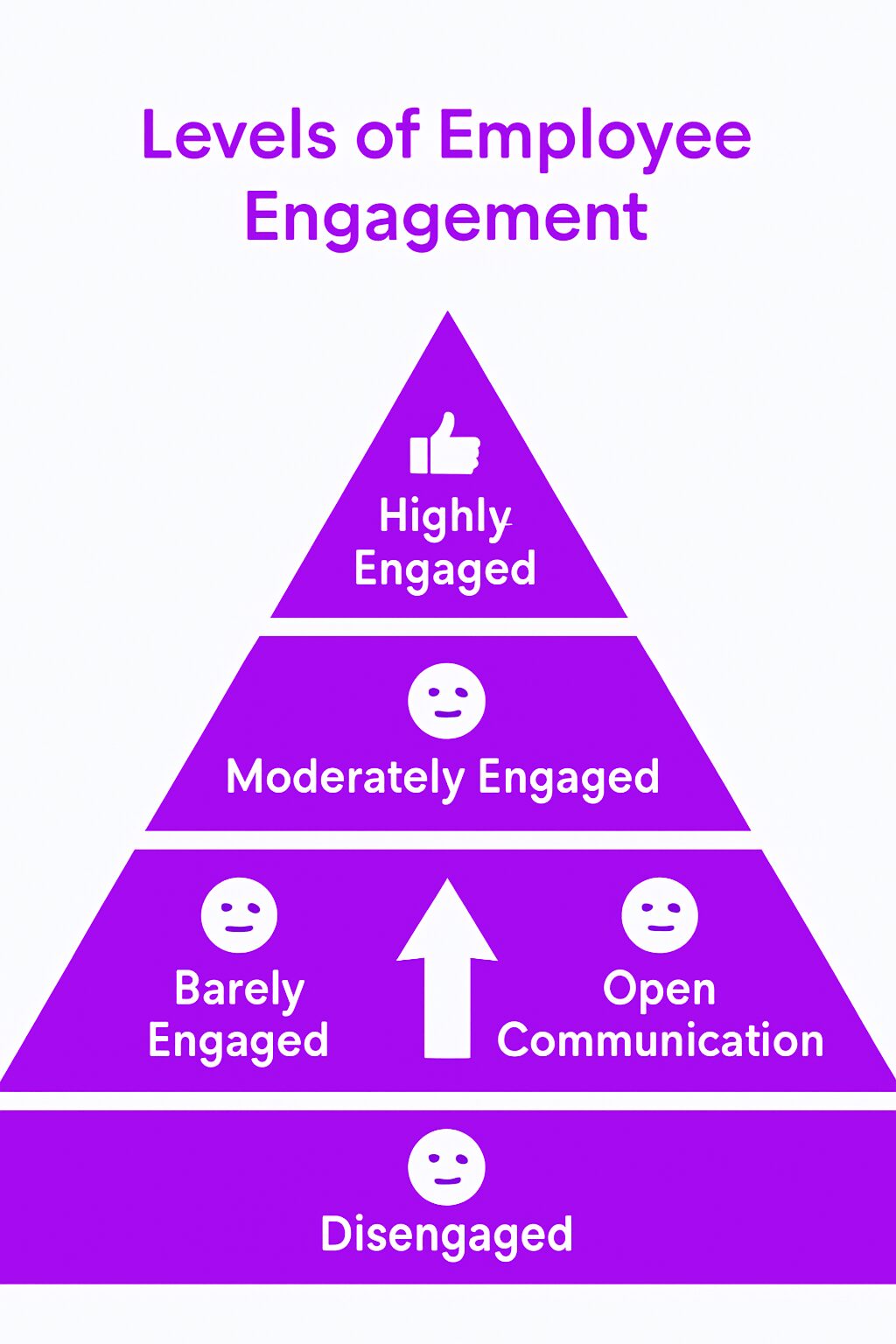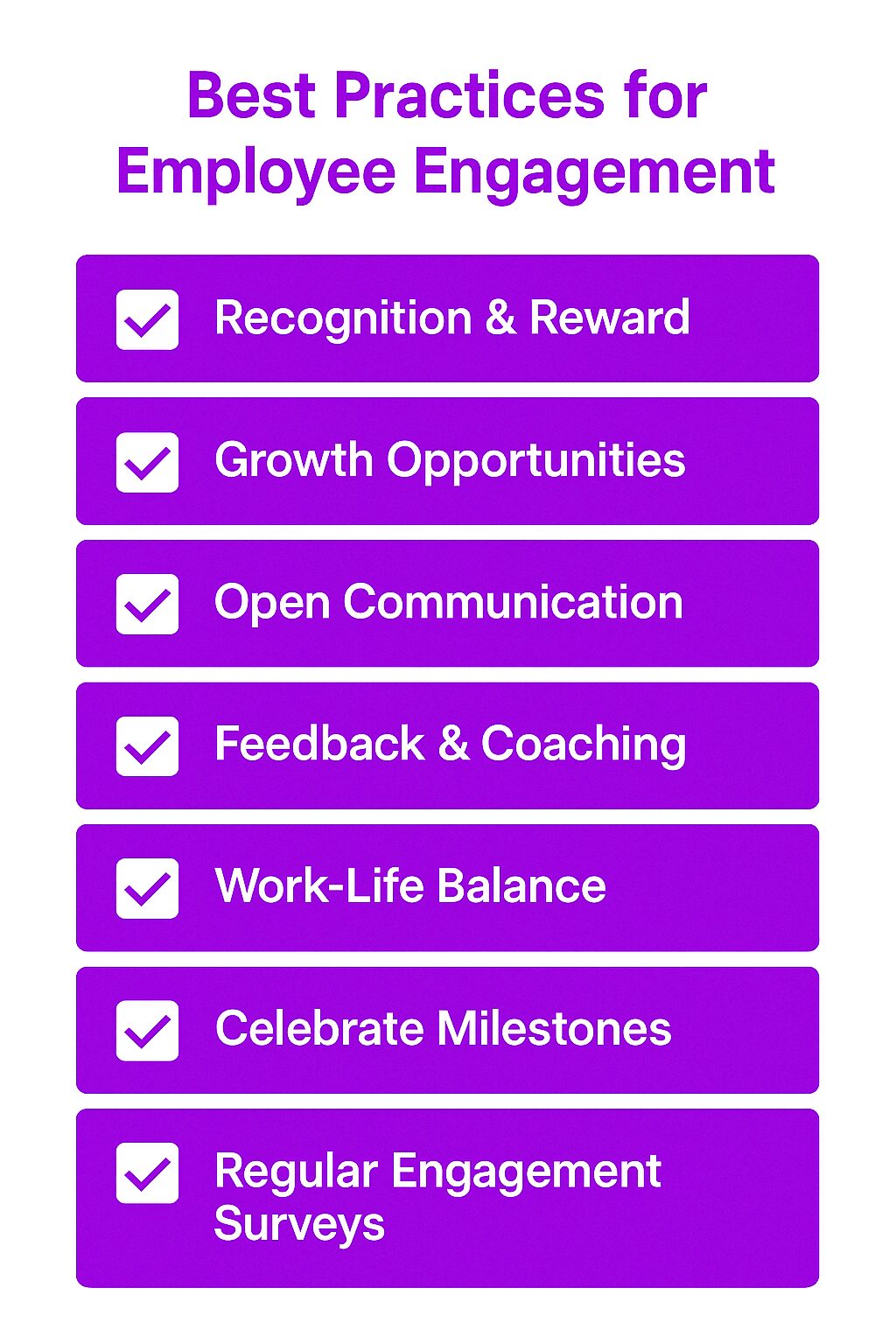What is Employee Engagement?
Employee engagement is the level of connection, enthusiasm, and commitment employees feel toward their work and their organization. Engaged employees do more than show up; they invest effort, contribute ideas, and work with a sense of purpose. Engagement is not just about job satisfaction. An employee can be satisfied but not engaged. Satisfaction is about comfort, while engagement is about motivation and involvement.
Why Employee Engagement Matters
Organizations with engaged employees perform better. Productivity is higher, customer satisfaction improves, and businesses retain talent longer. When employees care about their work, they go beyond their job descriptions. They collaborate, solve problems, and help shape company culture. Engaged employees are crucial for driving organizational success, as they contribute positively, exhibit discretionary effort, and enhance overall performance.
Disengagement has real costs. Low engagement leads to higher turnover, reduced productivity, and weaker morale. Employees who do not feel connected to their work are more likely to do the bare minimum or seek opportunities elsewhere.
The Different Levels of Employee Engagement
Highly Engaged Employees
Engaging employees are proactive, motivated, and take ownership of their work. They contribute ideas, support their teammates, and look for ways to improve processes. Organizations with a strong engagement culture often have high numbers of these employees.
Moderately Engaged Employees
They do their jobs well but do not go above and beyond. They may be content in their roles but lack strong emotional investment in the company’s mission. They could become more engaged with the right support or, if neglected, slip into disengagement.
Barely Engaged Employees
They do what is required but little more. They may feel disconnected from their work or the company. They do not take initiative and may be mentally checked out even when physically present.
Disengaged Employees
These employees are unhappy, unmotivated, and sometimes actively dissatisfied. They may spread negativity, resist change, or look for other job opportunities. If left unaddressed, disengagement can hurt teams and overall company culture.
What Drives Employee Engagement?
Leadership
Managers and executives set the tone for engagement. Employees look to leadership for direction, support, and recognition. Poor leadership can disengage employees quickly, while strong leadership builds trust and motivation. Implementing an effective employee engagement strategy is crucial for leaders to foster a culture of engagement and drive organizational success.
Career Growth
Employees want opportunities to learn and grow. If they do not see a path forward, they may disengage. Career development programs, mentorship, and clear advancement opportunities keep employees engaged.
Workplace Culture
Engagement is easier in a workplace that values transparency, collaboration, and respect. Employees need to feel safe to share ideas, make mistakes, and contribute without fear.
Recognition
People want to be appreciated. Acknowledging employees for their contributions—big or small—reinforces engagement. Recognition can be formal, like awards, or informal, like a simple thank-you.
Open Communication
Employees need to know their voices matter. Regular feedback, clear expectations, and open-door policies foster engagement. When employees feel heard, they are more likely to stay invested. Including well-crafted employee engagement survey questions can further enhance this open communication by effectively measuring employee satisfaction and engagement.
Work-Life Balance
Burnout kills engagement. Flexible schedules, remote work options, and respect for personal time help employees stay engaged long-term.
The Benefits of Employee Engagement
Increased Productivity
Increase employee engagement to ensure that employees work harder and smarter. They take initiative and focus on results, not just completing tasks.
Better Team Collaboration
Engaged employees contribute positively to team dynamics. They share ideas, help colleagues, and work toward common goals.
Lower Turnover
When employees feel valued, they are less likely to leave. Retaining employees saves businesses from the costs of recruiting and training new hires.
Improved Customer Experience
Engaged employees care about their work, which translates into better service. When employees believe in what they do, customers notice.
More Innovation
Employees who feel safe to express their ideas contribute to a culture of innovation. They are willing to take risks and suggest improvements without fear of failure.
Challenges of Employee Engagement
Measuring Engagement
Measuring employee engagement is not always easy. Surveys, performance reviews, and feedback sessions help gauge employee sentiment, but engagement is dynamic and can change over time.
Leadership Gaps
If managers do not prioritize engagement, employees will notice. Leaders who fail to communicate, provide feedback, or recognize achievements can disengage their teams.
Resistance to Change
Change can be unsettling. When companies introduce new policies, structures, or leadership, employees may struggle to stay engaged if they do not understand or support the changes.
Workload and Burnout
Too much work without balance can disengage employees. If employees feel overwhelmed, they may disengage to protect themselves from burnout.
How to Measure Employee Engagement
Engagement Surveys
Anonymous surveys give employees a voice. Well-designed questions can uncover strengths and weaknesses in engagement levels.
Key Performance Indicators
Metrics like absenteeism, productivity, and turnover rates can signal engagement issues.
One-on-One Check-Ins
Regular meetings with managers allow employees to share concerns and feedback. Open dialogue helps organizations catch disengagement early.
Feedback Tools
Digital feedback platforms encourage continuous engagement tracking. Employees can share insights in real time instead of waiting for annual surveys.
Strategies to Improve Employee Engagement
Build a Culture of Recognition
Employees who feel appreciated are more engaged. Recognizing hard work and contributions keeps motivation high.
Encourage Career Growth
Providing training programs, mentorship, and clear promotion paths helps employees stay invested in their roles.
Prioritize Open Communication
Transparent communication ensures employees understand company goals and their role in achieving them. When organizations engage employees by keeping them informed, they are more engaged.
Offer Flexibility
Supporting work-life balance through remote work options or flexible hours prevents burnout and keeps employees engaged.
Foster Leadership Development
Strong leadership drives engagement. Training managers to support, motivate, and empower their teams can make a significant difference.
Make Work Meaningful
Employees want to feel their work matters. Tying tasks to larger company goals helps employees see their impact on the entire organization.
The Role of Stakeholders in Employee Engagement
Employee engagement is a collective effort that requires the involvement of various stakeholders within an organization. These stakeholders include leadership, management, HR, and employees themselves. Each stakeholder plays a crucial role in fostering a culture of engagement and ensuring that employees feel valued, motivated, and committed to the organization’s goals.
Leadership sets the tone for employee engagement by modeling the behaviors and values they expect from their employees. They must communicate the importance of engagement and provide the necessary resources and support to make it a reality. Management, on the other hand, is responsible for implementing engagement strategies and providing feedback and coaching to employees. HR plays a critical role in developing and implementing employee engagement programs, as well as analyzing and acting on employee feedback.
Employees, too, have a significant role to play in their own engagement. They must take ownership of their work, seek feedback and opportunities for growth, and contribute to a positive and inclusive work environment. By working together, stakeholders can create a culture of engagement that drives business success and improves employee satisfaction.
Employee Engagement Software
Employee engagement software is a digital tool designed to measure and improve employee engagement. These platforms provide a range of features, including survey tools, feedback mechanisms, and analytics, to help organizations understand and address the needs of their employees. Employee engagement software can help organizations to:
-
Measure employee engagement through regular surveys and feedback.
-
Identify areas for improvement and develop targeted strategies.
-
Provide personalized feedback and coaching to employees.
-
Foster a culture of recognition and reward.
-
Analyze and act on employee data to drive business outcomes.
Some popular employee engagement software platforms include Qualtrics, Gallup, and 15Five. These platforms offer a range of features and tools to help organizations improve employee engagement and drive business success.
Creating an Employee Engagement Action Plan
Creating an employee engagement action plan is a critical step in improving employee engagement and driving business success. An action plan outlines the specific steps an organization will take to improve engagement, including goals, objectives, and timelines. Here are some steps to follow when creating an employee engagement action plan:
-
Conduct an employee engagement survey to understand the current state of engagement within the organization.
-
Analyze the data and identify areas for improvement.
-
Develop specific goals and objectives for improving engagement.
-
Identify the stakeholders who will be responsible for implementing the plan.
-
Develop a timeline for implementation and establish milestones and deadlines.
-
Establish metrics for measuring progress and evaluating success.
-
Communicate the plan to all stakeholders and ensure that everyone is aligned and committed to its success.
Best Practices for Employee Engagement
Here are some best practices for employee engagement:
-
Foster a culture of recognition and reward: Recognize and reward employees for their contributions and achievements.
-
Provide opportunities for growth and development: Offer training, mentorship, and opportunities for advancement.
-
Encourage open communication: Foster a culture of open and honest communication, where employees feel comfortable sharing their thoughts and ideas.
-
Conduct regular feedback and coaching: Provide regular feedback and coaching to employees to help them grow and develop.
-
Emphasize work-life balance: Encourage employees to maintain a healthy work-life balance and provide resources to support them.
-
Celebrate milestones and successes: Celebrate employees’ work anniversaries, years of service, and significant career milestones.
-
Conduct regular employee engagement surveys: Conduct regular surveys to understand the current state of engagement and identify areas for improvement.
Related Concepts
Employee Experience
The overall journey of an employee within a company influences engagement levels. From onboarding to career development, experience shapes engagement.
Employee Satisfaction
Satisfaction and engagement are related but different. An employee can be satisfied but not engaged. Engagement requires emotional investment in work.
Employee Retention
Engaged employees are more likely to stay. Retention strategies often overlap with engagement efforts.
Workplace Culture
Culture defines how employees interact, communicate, and collaborate. A positive workplace culture fosters engagement naturally.
Real-World Examples of Employee Engagement
Tech Industry
Companies like Google invest heavily in engagement through flexible work environments, professional development, and strong leadership.
Customer Service and Retail
Brands like Zappos empower employees to go beyond scripted interactions, fostering engagement and a strong customer experience.
Healthcare
Hospitals that engage frontline workers in decision-making see improved patient outcomes and job satisfaction.
Remote Work Environments
Companies that support remote employees with tools, clear communication, and recognition programs maintain high engagement levels despite physical distance.
Employee engagement is more than a buzzword. It shapes productivity, retention, and workplace culture. Companies that invest in engagement create better experiences for employees and better results for their business.
The Future of Employee Engagement
The future of employee engagement is likely to be shaped by a range of factors, including technological advancements, changing workforce demographics, and evolving employee expectations. Here are some trends that are likely to shape the future of employee engagement:
-
Increased use of technology: Technology will continue to play a critical role in employee engagement, with the use of AI, machine learning, and data analytics to personalize and optimize engagement strategies.
-
Greater emphasis on well-being: Organizations will place a greater emphasis on employee well-being, with a focus on mental health, physical health, and work-life balance.
-
More diverse and inclusive workplaces: Organizations will prioritize diversity, equity, and inclusion, with a focus on creating a culture of belonging and respect.
-
Increased focus on employee experience: Organizations will prioritize the employee experience, with a focus on creating a positive and engaging work environment.
-
Greater emphasis on continuous learning: Organizations will prioritize continuous learning and development, with a focus on upskilling and reskilling employees to meet the changing needs of the business.







